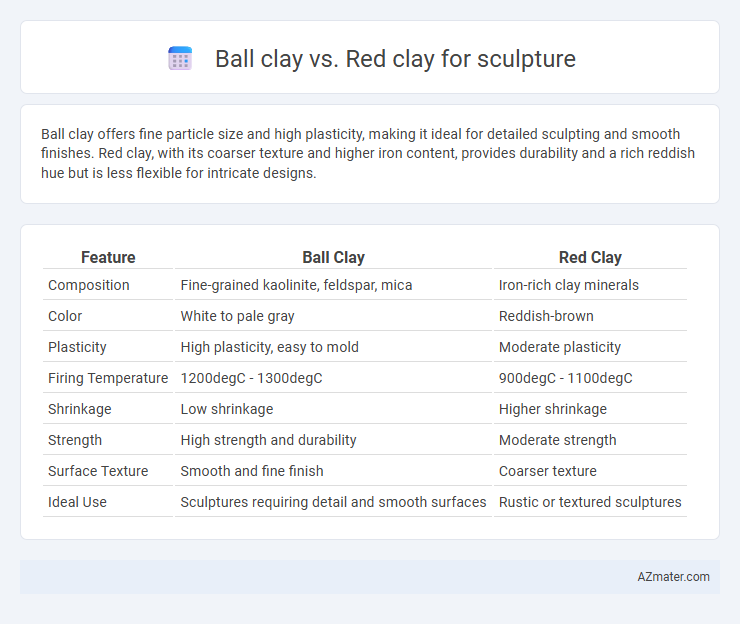Ball clay offers fine particle size and high plasticity, making it ideal for detailed sculpting and smooth finishes. Red clay, with its coarser texture and higher iron content, provides durability and a rich reddish hue but is less flexible for intricate designs.
Table of Comparison
| Feature | Ball Clay | Red Clay |
|---|---|---|
| Composition | Fine-grained kaolinite, feldspar, mica | Iron-rich clay minerals |
| Color | White to pale gray | Reddish-brown |
| Plasticity | High plasticity, easy to mold | Moderate plasticity |
| Firing Temperature | 1200degC - 1300degC | 900degC - 1100degC |
| Shrinkage | Low shrinkage | Higher shrinkage |
| Strength | High strength and durability | Moderate strength |
| Surface Texture | Smooth and fine finish | Coarser texture |
| Ideal Use | Sculptures requiring detail and smooth surfaces | Rustic or textured sculptures |
Introduction to Ball Clay and Red Clay
Ball clay features a fine, smooth texture and high plasticity, making it ideal for detailed sculpting and fine finishes. Red clay, characterized by its iron oxide content, offers a rich, earthy tone and a coarser texture suited for robust, rustic sculptures. Sculptors often select ball clay for precision work, while red clay is favored for its natural color and strength.
Geological Origins and Composition
Ball clay originates from sedimentary deposits rich in kaolinite, mica, and quartz, formed by the weathering of feldspar-rich rocks in ancient river basins. Red clay, commonly derived from lateritic soils, contains higher iron oxide content, giving it its characteristic red hue, and consists mainly of kaolinite and hematite. The distinct mineral composition and geological formation directly impact their plasticity, firing temperature, and color, making ball clay ideal for fine detailing and red clay preferable for rustic, earthy sculptures.
Physical Properties Comparison
Ball clay exhibits fine particles and high plasticity, making it ideal for intricate sculpting and detailed work, while red clay has coarser grains and lower plasticity, offering a denser and less pliable texture. Ball clay's high plasticity allows for greater flexibility and smooth shaping, whereas red clay's composition often includes iron oxides that contribute to its rigidity and earthy texture. The differing moisture absorption rates also impact drying times, with ball clay typically retaining more water, leading to slower drying and reduced cracking risk compared to red clay.
Plasticity and Workability
Ball clay exhibits high plasticity and excellent workability, making it ideal for intricate sculptural details and smooth shaping. Red clay has moderate plasticity but tends to be coarser, often resulting in less fine detail and a more textured finish. Sculptors seeking flexibility and ease of manipulation typically prefer ball clay for its superior malleability and consistent performance.
Color and Firing Characteristics
Ball clay offers a creamy white to light gray color, providing a smooth surface ideal for detailed sculpture work. It fires at higher temperatures around 1200-1300degC, resulting in a strong, vitrified body with slight translucency. Red clay features a rich, iron-oxide red tone that deepens after firing at lower temperatures near 1000-1100degC, producing a more porous, earthy texture suited for rustic sculptures.
Drying and Shrinkage Rates
Ball clay exhibits slower drying rates and lower shrinkage percentages, typically around 5-7%, making it ideal for detailed sculptures requiring minimal deformation. Red clay generally dries faster but has higher shrinkage rates between 8-12%, increasing the risk of cracks during the drying process. Sculptors often choose ball clay over red clay when precision and structural stability during drying are critical factors.
Strength and Durability for Sculpture
Ball clay offers greater plasticity and fine particle size, making it ideal for detailed sculpting but has moderate strength and can be prone to cracking during drying. Red clay, containing higher iron oxide content, generally provides increased durability and fired strength, making it better suited for robust sculptures and outdoor pieces. Choosing between ball clay and red clay depends on the balance needed between intricate work and long-term structural integrity in the sculpture.
Suitability for Detailed Work
Ball clay offers superior plasticity and fine particle size, making it ideal for detailed sculptural work that demands precision and smooth finishes. Red clay, while durable and robust, typically contains coarser particles and lower plasticity, which can limit the ability to achieve intricate details. Artists seeking fine textures and intricate designs generally prefer ball clay for its exceptional moldability and responsiveness.
Common Uses in Sculpture
Ball clay is highly favored in sculpture for its smooth texture and excellent plasticity, making it ideal for detailed modeling and fine finishing in ceramic sculptures. Red clay, with its higher iron content, provides a natural reddish hue and is commonly used for earthy, rustic sculptures that benefit from its sturdy and durable properties. Both clays serve distinct artistic purposes: ball clay excels in precision and finesse, while red clay is valued for its robust and organic aesthetic.
Choosing the Best Clay for Your Project
Ball clay offers a smooth texture and high plasticity, making it ideal for detailed sculpting and fine finishes in ceramics. Red clay, also known as terracotta, is coarser with lower plasticity but provides a warm, natural color and durability suitable for rustic or larger outdoor sculptures. Selecting the best clay depends on your project's needs for detail, firing temperature, color, and durability.

Infographic: Ball clay vs Red clay for Sculpture
 azmater.com
azmater.com